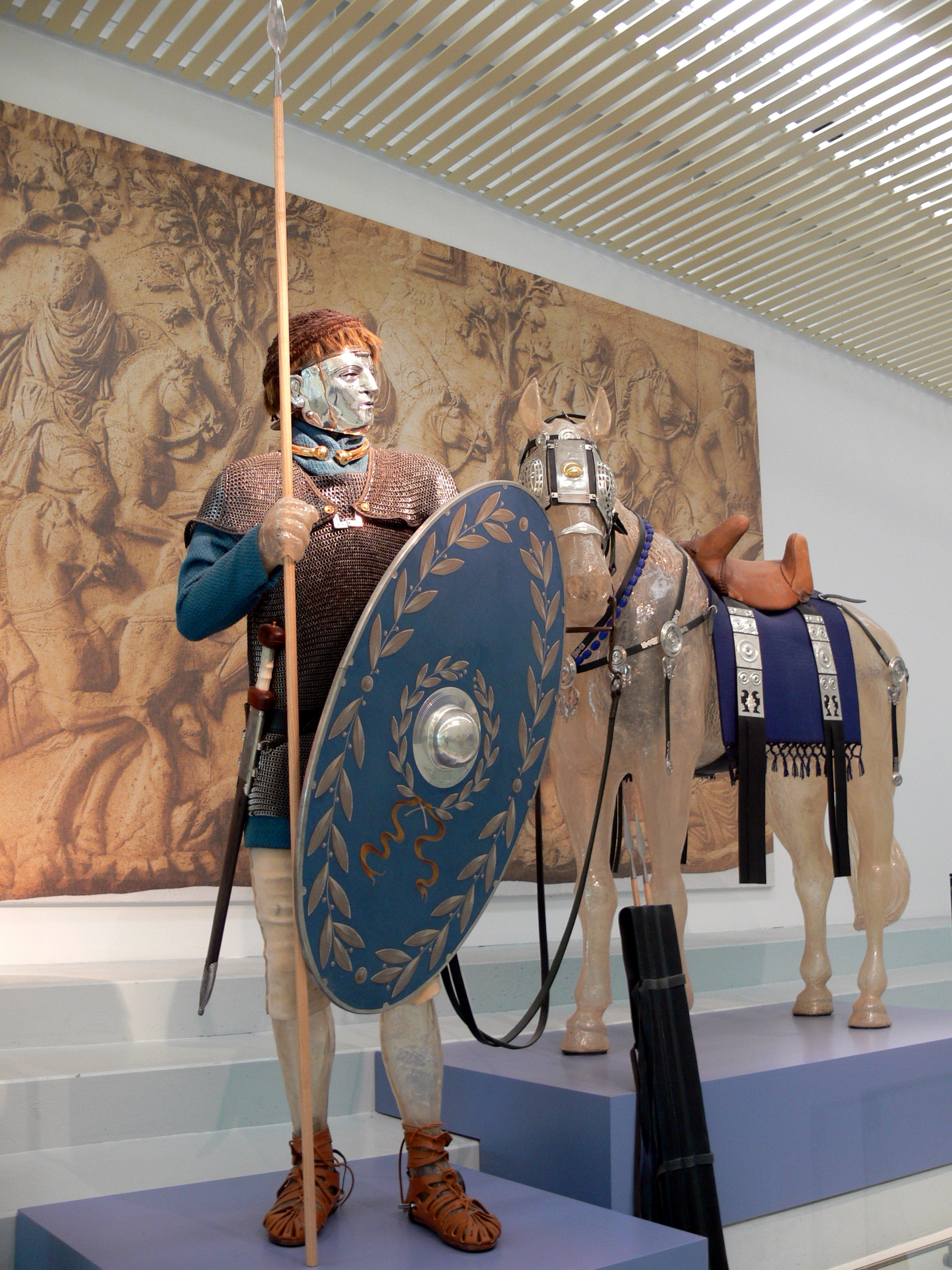Parma (shield) on:
[Wikipedia]
[Google]
[Amazon]
A ''parma'' or ''parmula'' (the diminutive of ''parma'') was a type of round shield used by the

Parma
(Smith's Dictionary of Greek and Roman Antiquities at
Roman
Roman or Romans most often refers to:
* Rome, the capital city of Italy
* Ancient Rome, Roman civilization from 8th century BC to 5th century AD
*Roman people, the people of ancient Rome
*''Epistle to the Romans'', shortened to ''Romans'', a lett ...
army
An army (from Old French ''armee'', itself derived from the Latin verb ''armāre'', meaning "to arm", and related to the Latin noun ''arma'', meaning "arms" or "weapons"), ground force or land force is a fighting force that fights primarily on ...
, especially during the later period of imperial history since 3rd century
The 3rd century was the period from 201 ( CCI) to 300 ( CCC) Anno Domini (AD) or Common Era (CE) in the Julian calendar..
In this century, the Roman Empire saw a crisis, starting with the assassination of the Roman Emperor Severus Alexande ...
.
Characteristics
The ''parma'' was about 36 inches (91 cm) across (or less) and had iron in its frame, making it a very effective piece of armour. ''Parmae'' had handles and shield bosses (''umbones''). The ''parma'' was used by legionnaires in the early republican period of Rome's history, by the lowest class division of the army— the ''velites
''Velites'' (singular: ) were a class of infantry in the Roman army of the mid-Republic from 211 to 107 BC. ''Velites'' were light infantry and skirmishers armed with javelins ( la, hastae velitares), each with a 75cm (30 inch) wooden shaft the ...
''. Their equipment consisted of a ''parma'', javelin, sword and helmet. Later, the ''parma'' was replaced by the body-length ''scutum
The ''scutum'' (; plural ''scuta'') was a type of shield used among Italic peoples in antiquity, most notably by the army of ancient Rome starting about the fourth century BC.
The Romans adopted it when they switched from the military formatio ...
'' as ''velites'' were phased out with the Marian reforms
The Marian reforms were reforms of the ancient Roman army implemented in 107 BC by the statesman Gaius Marius, for whom they were later named. The reforms originated as a reaction to the military and logistical stagnation of the Roman Republic ...
. 
War use
It was used mainly by auxiliary infantry and cavalry, with the legionaries preferring the heavier but more protective ''scutum'', during earlier periods. It was used also by ''signifer
A ''signifer'' () was a standard bearer of the Roman legions. He carried a ''signum'' ( standard) for a cohort or century. Each century had a ''signifer'' so there were 59 in a legion. Within each cohort, the first century's ''signifer'' would ...
i'' (standard bearers).
In Virgil
Publius Vergilius Maro (; traditional dates 15 October 7021 September 19 BC), usually called Virgil or Vergil ( ) in English, was an ancient Roman poet of the Augustan period. He composed three of the most famous poems in Latin literature: th ...
's ''Aeneid
The ''Aeneid'' ( ; la, Aenē̆is or ) is a Latin epic poem, written by Virgil between 29 and 19 BC, that tells the legendary story of Aeneas, a Trojan who fled the fall of Troy and travelled to Italy, where he became the ancestor of ...
'', the ''parma'' is cited as a weapon utilised by the Teucrians in defence against the Greeks ( Battle of Troy), and later against the Rutulians.
Other uses
The ''parmula'' was the shield used by thraex gladiators. It was also used by the Roman ''vexilliferi'' or flag bearers that carried the standard that marked thecohort
Cohort or cohortes may refer to:
* Cohort (educational group), a group of students working together through the same academic curriculum
* Cohort (floating point), a set of different encodings of the same numerical value
* Cohort (military unit) ...
, as well as by most early auxiliaries.
In the Pyrrhic dance
The Pyrrhichios or Pyrrhike dance ("Pyrrhic dance"; Ancient Greek: πυρρίχιος or πυρρίχη, but often misspelled as πυρρίχειος or πυρήχειος) was the best known war dance of the Greeks. It was probably of Dorian ori ...
it was raised above the head and struck with a sword so as to emit a loud ringing noise.
See also
* Clipeus * Roman military personal equipmentReferences
External links
Parma
(Smith's Dictionary of Greek and Roman Antiquities at
LacusCurtius
LacusCurtius is a website specializing in ancient Rome, currently hosted on a server at the University of Chicago. It went online on August 26, 1997; in July 2021 it had "3707 webpages, 765 photos, 772 drawings & engravings, 120 plans, 139 maps." T ...
)
Roman shields
Roman auxiliaries
Late Roman military
{{AncientRome-mil-stub